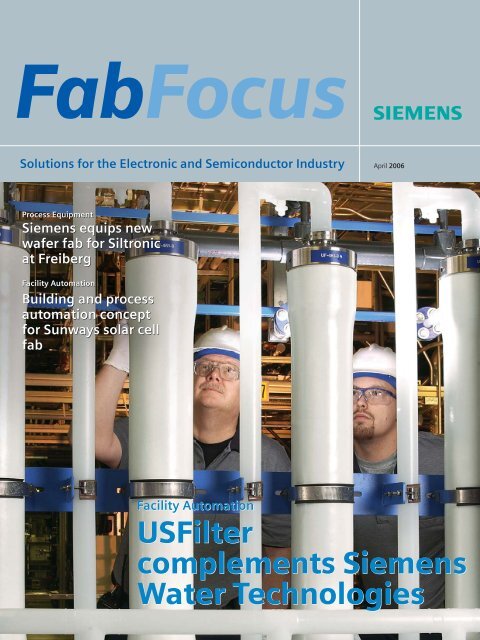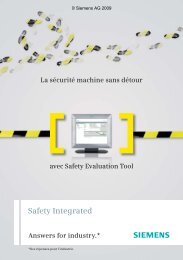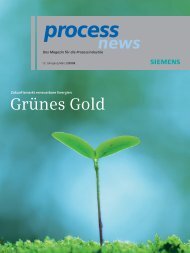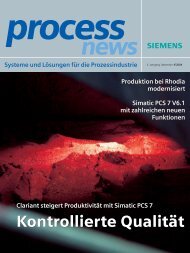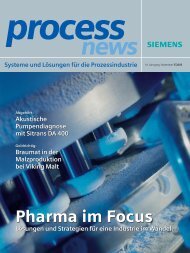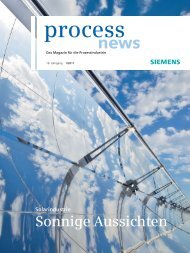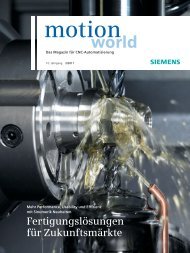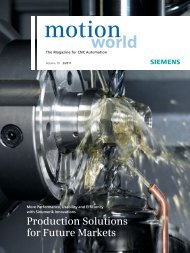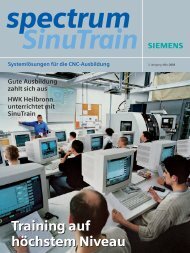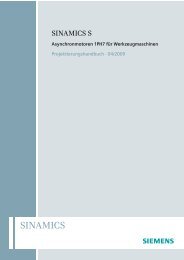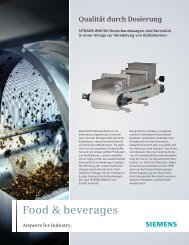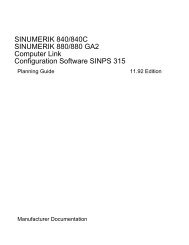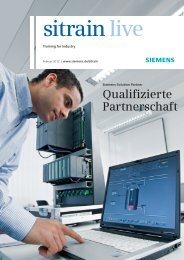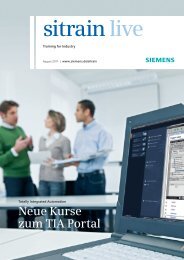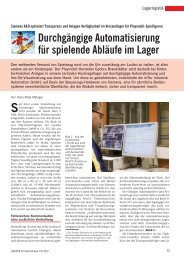Download edition 2006 - Siemens
Download edition 2006 - Siemens
Download edition 2006 - Siemens
Create successful ePaper yourself
Turn your PDF publications into a flip-book with our unique Google optimized e-Paper software.
FabFocus<br />
Solutions for the Electronic and Semiconductor Industry<br />
Process Equipment<br />
<strong>Siemens</strong> equips new<br />
wafer fab for Siltronic<br />
at Freiberg<br />
Facility Automation<br />
Building and process<br />
automation concept<br />
for Sunways solar cell<br />
fab<br />
Facility Automation<br />
s<br />
April <strong>2006</strong><br />
USFilter<br />
complements <strong>Siemens</strong><br />
Water Technologies
2 CONTENT EDITORIAL<br />
2 EDITORIAL<br />
FACILITY<br />
AUTOMATION<br />
3 Global solutions for<br />
a universal solvent<br />
USFilter acquisition offers<br />
<strong>Siemens</strong> a promising water<br />
platform<br />
5 Flowing with<br />
innovative ideas<br />
<strong>Siemens</strong> water Technologies<br />
offers clients tailored water<br />
treatment solutions<br />
6 Saving big on energy<br />
<strong>Siemens</strong> Energy Management<br />
systems help to optimize energy<br />
cost savings potential<br />
8 High-powered<br />
solar performance<br />
Integrated building and<br />
process automation concept<br />
at new Sunways solar cell fab<br />
10 Pulling it all together<br />
<strong>Siemens</strong> supplies comprehensive<br />
solutions package for new<br />
Infineon fab in Malaysia<br />
12 Consistently successful<br />
New wafer fab benefits from a<br />
high degree of standardization<br />
and an experienced project<br />
management team<br />
FabFocus<br />
Publisher<br />
<strong>Siemens</strong> Aktiengesellschaft,<br />
Automation & Drives Division (A&D),<br />
Nuremberg<br />
Group Executive Management<br />
Helmut Gierse, Hannes Apitzsch,<br />
Dr. Peter Drexel, Anton S. Huber<br />
Responsible for content<br />
Peter Miodek<br />
Responsible for technical content<br />
Gerd Limmer<br />
gerd.limmer@siemens.com<br />
Andrea Lüdecke<br />
andrea.luedecke@siemens.com<br />
14 The joint work<br />
of specialists<br />
M+W Zander sets up an entire<br />
factory in just two years<br />
PROCESS<br />
EQUIPMENT<br />
15 Production cell integration<br />
Simatic and Sinumerik<br />
technology in etching tool<br />
at Siltronic<br />
16 Wafer handling with<br />
the robotic touch<br />
KUKA partners with <strong>Siemens</strong> to<br />
optimize robot integration<br />
18 Maximizing miniature<br />
placement<br />
ASE relies on Siplace placement<br />
machines for its 0201<br />
component production<br />
20 Defining the<br />
progressive edge<br />
<strong>Siemens</strong> instrumental in<br />
advancing new MVD technology<br />
Publishing house<br />
Publicis KommunikationsAgentur GmbH,<br />
Corporate Publishing<br />
P.O. Box 3240, 91050 Erlangen<br />
Phone +49 (0) 9131/91 92-5 21<br />
Telefax +49 (0) 9131/91 92-5 94<br />
Coordination: Sabine Zingelmann<br />
Artwork and layout: Juergen Streitenberger<br />
DTP<br />
Doess, Nuremberg<br />
Printed by<br />
Stuertz AG, Wuerzburg<br />
© <strong>2006</strong> by <strong>Siemens</strong> Aktiengesellschaft<br />
Berlin and Munich.<br />
21 NEWS/PRODUCTS<br />
You can also visit us at the following trade shows:<br />
• SEMICON Europa <strong>2006</strong> in Munich, Germany, April 4–6, <strong>2006</strong><br />
• SEMICON West <strong>2006</strong> in San Francisco, USA, July 11–13, <strong>2006</strong><br />
And this year for the first time:<br />
• Hannover Messe Hanover, Germany, April 24–28, <strong>2006</strong><br />
All rights reserved<br />
by the publisher.<br />
“FabFocus” is printed on<br />
100% recycled paper.<br />
Printed in Germany<br />
002100 RÖE61 0406<br />
Circulation: 5.500<br />
E20001-A110-P250-X-7600<br />
Dear readers,<br />
“Act today – focus on<br />
tomorrow” is the<br />
patented formula<br />
which best sums up<br />
our success. Engaging<br />
in tomorrow’s global<br />
trends and challenges<br />
today already enables<br />
us to provide our customers in the semiconductor<br />
industry optimal support – now and in the future.<br />
The creation of our <strong>Siemens</strong> Competence Center<br />
for the semiconductor industry played a pivotal<br />
role in helping us to analyze the requirements of<br />
the market as well as the current demands of our<br />
customers. These data in turn help us to coordinate<br />
our activities in developing top-notch fab<br />
industry solutions.<br />
Take, for example, the issue of “energy management,”<br />
rapidly gaining in importance particularly<br />
in highly developed countries. Thanks to our<br />
research, many of our customers are now very<br />
interested in leveraging the benefits of the costefficient<br />
energy solutions outlined in the article<br />
on pages 6 and 7.<br />
The examples provided by the other featured<br />
articles in this <strong>edition</strong> of FabFocus also convincingly<br />
underscore our continued dedication to<br />
forward-oriented technologies. Apart from<br />
innovative technological solutions, however,<br />
“acting today and focusing on tomorrow” also<br />
involves strategic acquisitions. Case in point:<br />
the recent acquisition of USFilter (now <strong>Siemens</strong><br />
Water Technologies). While the economical water<br />
treatment systems of the North American market<br />
leader very logically compliment and expand the<br />
<strong>Siemens</strong> industrial portfolio, they also position<br />
us well for the budding global environmental<br />
protection market – an industry which promises<br />
to grow in leaps and bounds in the coming years,<br />
as the cover story on pages 5 and 6 illustrates.<br />
Resolute commitment to future technologies<br />
through a well-balanced, coherent portfolio will<br />
enable us to position ourselves well today and in<br />
the future – together with our customers.<br />
Gerd Limmer<br />
Director Competence Center<br />
Semiconductor Industry<br />
Gerd Limmer, <strong>Siemens</strong> Nuremberg<br />
E-mail: gerd.limmer@siemens.com<br />
FabFocus <strong>2006</strong>
FACILITY AUTOMATION<br />
USFilter acquisition offers <strong>Siemens</strong> a promising<br />
water platform<br />
Global solutions<br />
for a universal solvent<br />
Water is undoubtedly one of the world’s most precious resources and an<br />
integral part of every manufacturing process, including those of the electronics<br />
industry. In 2004, <strong>Siemens</strong> purchased USFilter, a world leader in water and<br />
wastewater treatment equipment and services. In the following interview,<br />
Alan Knapp, director of the electronics market and strategic accounts at<br />
USFilter (a.k.a. <strong>Siemens</strong> Water Technologies), offers his insights on the<br />
importance of the acquisition and of water for the semiconductor industry.<br />
Why is <strong>Siemens</strong> increasing its focus<br />
on water?<br />
Alan Knapp: The water industry will<br />
spend approximately $400 billion dollars<br />
this year purchasing equipment and services<br />
for everything from municipal drinking<br />
water systems to boiler feed water systems.<br />
The industry continues to grow as<br />
demands for purified water increase and<br />
the available fresh water supply shrinks.<br />
Many areas of the world are growing economically<br />
but lack the infrastructure to deliver<br />
clean water for municipalities or industrial<br />
users. In addition to fresh water,<br />
customers need waste treatment solutions<br />
to protect the environment and existing<br />
tributaries.<br />
Who is USFilter/<strong>Siemens</strong> Water<br />
Technologies?<br />
Alan Knapp: USFilter was incorporated in<br />
the early 1990s by a group of entrepreneurs<br />
FabFocus <strong>2006</strong><br />
with the vision of building a “one-stop<br />
shop” for industrial, commercial and municipal<br />
customers in the water and wastewater<br />
treatment market. By assembling the<br />
best technologies and service offerings<br />
from small companies, USFilter was able<br />
to bring a large portfolio to a varying customer<br />
base.<br />
Recognizing its opportunity to enter the<br />
market, <strong>Siemens</strong> purchased USFilter in<br />
2004, which will be known globally as<br />
“<strong>Siemens</strong> Water<br />
Technologies offers<br />
a complete pure<br />
water and<br />
wastewater solution<br />
to the industry”<br />
Alan Knapp<br />
Publicis CPZ<br />
<strong>Siemens</strong> Water Technologies as of October<br />
<strong>2006</strong>. With the product and service offerings<br />
of USFilter in the water and wastewater<br />
markets, <strong>Siemens</strong> is now able to offer the<br />
technological expertise of both companies<br />
to customers on an international level<br />
through a worldwide network of sales.<br />
How important is water?<br />
Alan Knapp: Water is the world’s “universal<br />
solvent” and, at the same time, the<br />
“lifeblood” for the human race. The water<br />
used in the critical manufacturing process,<br />
however, whether for growing and cutting<br />
a wafer or for producing a microprocessor,<br />
requires process expertise which can<br />
deliver water with extremely low impurity<br />
levels – less than one part per trillion. There<br />
is a major emphasis on delivering water of<br />
the highest purity to their process, while<br />
protecting the environment by treating<br />
waste streams and conserving water used<br />
within the manufacturing process.<br />
What do you provide specifically for the<br />
electronics industry?<br />
Alan Knapp: <strong>Siemens</strong> Water Technologies<br />
offers a complete pure water and wastewater<br />
solution to the industry, providing<br />
integrated treatment systems for the manufacturing<br />
process, protecting the environment<br />
and reclaiming wa-<br />
ter through treatment<br />
processes to conserve<br />
this precious commodity.<br />
Our core competency is<br />
to provide technology,<br />
quality equipment, services<br />
and reliable process<br />
solutions so that our customers<br />
can focus on what<br />
they do best.<br />
3
4 FACILITY AUTOMATION<br />
USFilter<br />
Are there different demands in different<br />
regions of the world?<br />
Alan Knapp: Not for a given manufacturing<br />
process. However, the feed water quality,<br />
environmental conditions, regulatory<br />
requirements and quantity of fresh water<br />
available drive the need for a variety of different<br />
treatment approaches. Environmental<br />
protection agencies set minimum discharge<br />
requirements for treating wastewater<br />
effluent, and most companies treat to<br />
a level that exceeds local regulations. The<br />
cost and availability of water, as well as effluent<br />
treatment restrictions, drive the<br />
need for innovative technology. Now, for<br />
example, wastewater that would normally<br />
be discharged from the facility can be reclaimed<br />
and re-injected into the process<br />
water for manufacturing.<br />
In detail, what does the <strong>Siemens</strong> Water<br />
Technologies offering include?<br />
Alan Knapp: <strong>Siemens</strong> Water Technologies<br />
offers a full range of technologies and services<br />
for all the needs within a facility’s central<br />
utility building. We own, manufacture<br />
and supply a wide variety of equipment and<br />
products including filters, ion exchange<br />
resin, continuous deionization units, membranes,<br />
clarifiers, chemical feed units, biological<br />
treatment systems, stripper/scrubber<br />
units, and filter presses, to name just a few.<br />
UV treatment is one of the solutions in the<br />
<strong>Siemens</strong> Water Technologies portfolio<br />
In addition to equipment solutions, we<br />
offer experienced operations and preventative<br />
maintenance service for our equipment<br />
or that of other manufacturers. Outsourcing<br />
with <strong>Siemens</strong> means no downtime!<br />
We consider ourselves a part of the<br />
customer’s factory team. This allows our<br />
customers the ability to focus on the<br />
manufacturing process and on improving<br />
yields.<br />
How will <strong>Siemens</strong> Water Technologies<br />
benefit <strong>Siemens</strong>?<br />
Alan Knapp: As part of the <strong>Siemens</strong> Industrial<br />
Solutions and Services division,<br />
<strong>Siemens</strong> Water Technologies is an integral<br />
member of the Competence Center Semiconductor<br />
Industry, providing an avenue to<br />
market – equipping our customers with<br />
many solutions in the manufacturing fab<br />
and support facility as one company. Together<br />
with <strong>Siemens</strong> Energy and Automation,<br />
we can offer an integrated system<br />
using <strong>Siemens</strong>-based controls and components,<br />
reducing the number of vendors a<br />
customer may have on a given system.<br />
And what about the customers?<br />
How will they benefit?<br />
Alan Knapp: As the director of the electronics<br />
market and strategic accounts, my<br />
team and I are customer focused. Driving<br />
USFilter<br />
Bildhinweis<br />
technology is what the electronics marketplace<br />
is all about. In many instances, we<br />
are aiding our customers by providing the<br />
insight, process experience, testing and analytical<br />
data to develop waste systems specific<br />
to their waste requirements. An example<br />
of that is our ammonia-treatment<br />
design for a large US microchip manufacturer.<br />
What does the future hold<br />
for the industry?<br />
Alan Knapp: In the past, the electronics industry<br />
has been very cyclical. As we continue<br />
down the path of digitalization, and<br />
as more countries grow economic-dependent,<br />
the demand for the microprocessor<br />
will bring continued opportunities for<br />
<strong>Siemens</strong> Water Technologies. The growth in<br />
flash memory, sustained logic processors,<br />
introduction of the photovoltaic and flat<br />
panel display, has contributed to industry<br />
growth. Manufacturers are better at managing<br />
demand for their product while creating<br />
new products. I believe we have the<br />
platform for solid sustained growth in a<br />
maturing market.<br />
Mr. Knapp, thank you for taking the time<br />
to speak with us.<br />
With an increasing demand for purified water and shrinking<br />
fresh water supplies, water treatment is a growth market<br />
FabFocus <strong>2006</strong>
FACILITY AUTOMATION<br />
<strong>Siemens</strong> Water Technologies offers clients tailored<br />
water treatment solutions<br />
Flowing with<br />
innovative ideas<br />
Two case studies convincingly illustrate the benefits of the tailor-made water<br />
treatment solutions of <strong>Siemens</strong> Water Technologies. In the first application,<br />
the addition of several tools at the facility of a US manufacturer required an<br />
increase in water consumption. This led the company to explore treatment<br />
options that would increase water availability by using the existing equipment,<br />
and to minimize capital cost and required floor space.<br />
The system consisted of a conventional<br />
makeup system using filtration, a<br />
double pass reverse osmosis (RO)<br />
membrane, ultraviolet light and mixed bed<br />
equipment. Expanding the equipment would<br />
have required a sizable capital equipment<br />
investment and increased operating costs.<br />
Moreover, there was no available floor space.<br />
The original system process design included<br />
ultra-filtration (UF) equipment where<br />
5 percent of the UF reject is returned ahead<br />
of the makeup RO. By installing a new reject<br />
UF, 95 percent of the reject flow is sent<br />
directly to the UPW tank, thereby reducing<br />
the load on the makeup system. The remaining<br />
reject stream continues to feed<br />
back ahead of the makeup RO equipment<br />
for a complete reclaim of the flow.<br />
Now, 182 liters per minute of water are<br />
reclaimed directly back to the UPW tank, increasing<br />
makeup capacity also by the same<br />
amount. This approach saved an additional<br />
$200,000 over a conventional makeup system<br />
expansion.<br />
The system proved to be a very reliable,<br />
simple and inexpensive way for the cus-<br />
FabFocus <strong>2006</strong><br />
tomer to increase makeup capacity by<br />
approximately 10 percent. In addition to<br />
increased quality and reliability, operating<br />
costs were also lowered – what is more, at reduced<br />
required floor space (only 1.4 square<br />
meters).<br />
Multistage ammonia wastewater<br />
treatment<br />
A large US semiconductor manufacturer required<br />
an ammonia treatment system to<br />
treat approximately 150 liters per minute of<br />
ammonia bearing wastewater. Design criteria<br />
included 24-hour per day operation and<br />
a system uptime of 99.5 percent or greater<br />
with the overall goal of reducing the<br />
amount of waste trucked off site. <strong>Siemens</strong><br />
Water Technologies was selected to provide<br />
a solution for this unique waste stream.<br />
Because the waste stream contained a<br />
number of contaminants in addition to ammonia<br />
at substantial concentrations, the<br />
customer preferred a modular approach<br />
using multiple units with incremental flow<br />
rates to treat to a low level of ammonia both<br />
in the aqueous and gas phase effluents.<br />
Tailor-made treatment solutions<br />
frequently lead to substantial<br />
process benefits<br />
<strong>Siemens</strong> Water Technologies designed a<br />
process capable of maintaining a steady pH<br />
with varying flow rates and influent contaminant<br />
concentrations. The pH adjusted<br />
water is then treated using multiple skidmounted,<br />
dual stage strippers and absorbers.<br />
These modules were constructed as<br />
a single FRP integrated system, with internal<br />
walls separating the unit processes, and<br />
can be brought online as needed to match<br />
influent flow requirements. As a result, the<br />
need for on-site construction was reduced<br />
and the overall footprint required by the<br />
modules kept to a minimum.<br />
Offering system redundancy and very<br />
high system availability without the need<br />
for a duplicate standby treatment system,<br />
the system exceeded the customer’s treatment<br />
requirements and expectations. Use<br />
of the multistage stripper allows a low profile<br />
system while maintaining stripping efficiency.<br />
�<br />
Alan Knapp,<br />
<strong>Siemens</strong> Water Technologies Portland<br />
E-mail: alan.knapp@siemens.com<br />
USFilter<br />
5
6 FACILITY AUTOMATION<br />
David Parker, Science Photo Library<br />
<strong>Siemens</strong> Energy Management systems help to optimize<br />
energy cost savings potential<br />
Saving big on energy<br />
Energy conservation plays an important role in safeguarding the environment<br />
for future generations – an awareness which is also rapidly gaining in popularity<br />
within the semiconductor industry. Prompted in part by stiffer regulatory<br />
guidelines within the industry, fab operators are also increasingly discovering<br />
that energy cost management solutions such as those provided by <strong>Siemens</strong><br />
really pay off.<br />
While, on the one hand, the liberalization<br />
of the energy market<br />
in Europe has significantly extended<br />
the options of semiconductor fab<br />
operators for negotiating favorable condi-<br />
tions with respect to energy supply, power<br />
distribution equipment such as circuit<br />
breakers or protection relays now enable<br />
energy consumption values to be continuously<br />
monitored. This increased energy<br />
<strong>Siemens</strong> Energy<br />
Management<br />
services at a glance<br />
Operating and monitoring: Displays<br />
the current plant status, allows for<br />
operation of the actors (switchgear),<br />
concisely presents historic load curves<br />
Reports: Clear, configurable output of<br />
load curves and indication lists<br />
Archive: Stores historical load curves<br />
over long periods of time and possesses<br />
configurable data consolidation<br />
functions<br />
Load shedding: Conducts short-term<br />
supervision of energy consumption<br />
(typically 15 minutes)<br />
Load forecasting: Delivers energy<br />
consumption forecasts based on the<br />
production schedule (anywhere from<br />
several hours to several days)<br />
Cost center allocation: Calculates the<br />
cost of the energy consumed and<br />
assigns it to cost centers<br />
Power quality: Power quality data<br />
collection<br />
Maintenance: Supports scheduled<br />
maintenance and provides fast notification<br />
in the event of a breakdown<br />
transparency brings with it the potential<br />
for significantly improved energy management<br />
– and cost savings.<br />
<strong>Siemens</strong> Energy Management systems<br />
offer customers solutions to precisely analyze<br />
and forecast energy costs, including<br />
monitoring, data collection and evaluation,<br />
as well as load forecasting and load shedding<br />
services.<br />
Technical building blocks<br />
An Ethernet/IP network forms the backbone<br />
of the <strong>Siemens</strong> Energy Management systems<br />
as the common communications platform.<br />
At the field level, Profinet and IEC<br />
61850 devices can be directly connected to<br />
the network. For devices with other physical<br />
interfaces, gateways are provided.<br />
A Simatic S7 PLC and a Windows PC<br />
server to run the archiving and evaluation<br />
FabFocus <strong>2006</strong>
functions generally handle the data collection<br />
of the <strong>Siemens</strong> Energy Management<br />
system. For moderate requirements (e.g.,<br />
data collection only) a soft PLC such as<br />
Simatic WinAC is sufficient and can physically<br />
run on the server PC. Several data collection<br />
PLCs, on the other hand, can be used<br />
for large configurations. Field devices deliver<br />
their information to the PLC, which<br />
buffers and archives them in a database on<br />
the PC server.<br />
Monitoring and reports<br />
Monitoring and report services provide a<br />
concise overview of the fab’s energy flow.<br />
Recorded load data is displayed in a clear<br />
layout, revealing major consumers and indicating<br />
priorities for energy optimization.<br />
Monitoring and report services also signal<br />
high-load events as well as situations<br />
which typically cause such load peaks.<br />
This information can in turn be used to develop<br />
strategies to avoid such critical situations.<br />
Load shedding<br />
Load measurements are generally taken as<br />
mean values over a short period of time. To<br />
keep demand below a predefined threshold,<br />
it is important to determine the amount<br />
Power Transmission<br />
and Distribution<br />
<strong>Siemens</strong> Power Transmission and<br />
Distribution (PTD) offers complete electrical<br />
energy supply solutions on a global<br />
scale ranging from 72.5 to 800kilovolts,<br />
as well as life-cycle services covering<br />
everything from the power feed to energy<br />
network consumers as well as emergency,<br />
safety and communications networks.<br />
The portfolio includes solutions<br />
competence and country-specific knowhow<br />
for the planning and implementation<br />
of both national and international projects,<br />
turnkey expertise, project management,<br />
export management and the<br />
integration of local suppliers as part of<br />
a comprehensive solutions package.<br />
More information:<br />
www.siemens.com/energy<br />
FabFocus <strong>2006</strong><br />
<strong>Siemens</strong> AG<br />
of energy consumed at the end of the current<br />
interval as quickly as possible.<br />
It may be necessary to throttle down or<br />
turn off some consumers at short notice.<br />
Such drastic actions should not be implemented<br />
spontaneously. Load shedding<br />
modules in the <strong>Siemens</strong> Energy Management<br />
systems offer the possibility of specifying<br />
a “turn-off strategy” precisely designating<br />
which consumers to turn off and in<br />
which order.<br />
Load forecasting<br />
Load forecasting provides a preview of a<br />
fab’s load curve over a similar time frame<br />
as the production schedule – anywhere from<br />
several hours to several days in advance.<br />
The load forecasting system generally<br />
records data on production process behavior<br />
in typical production situations. When<br />
a fab is given a production schedule, production<br />
is performed based on a characteristic<br />
energy consumption pattern. These<br />
data are metered as a load curve. The combination<br />
of the production schedule and<br />
the resulting load curve is stored in the<br />
load curve database.<br />
Once enough information is collected,<br />
load forecasts are made. Based on the collected<br />
load curve data, and combined with<br />
data on the future production schedule,<br />
the forecasting system selects those load<br />
curves which were produced for similar<br />
schedules.<br />
The benefits of energy transparency<br />
<strong>Siemens</strong> Energy Management employs<br />
state-of-the-art tools such as monitoring,<br />
load shedding and load forecasting to<br />
allow customers to detect and more efficiently<br />
manage their energy consumption.<br />
The benefits of the increased energy<br />
consumption transparency are numerous.<br />
Monitoring reports provide an overview<br />
of energy usage, signaling load peaks and<br />
potential areas for significant energy reduction.<br />
Load shedding is designed to<br />
avoid load peaks by temporarily turning<br />
off consumers and, as a result, postponing<br />
energy consumption. The load curve is<br />
smoothed and the level of demand cost<br />
lowered. Load forecasting signals load<br />
peaks several hours or even days in advance,<br />
allowing for ample time to adjust<br />
the production schedule.<br />
�<br />
Dr. Norbert Ploett, <strong>Siemens</strong> Nuremberg<br />
E-mail: norbert.ploett@siemens.com<br />
7
8 FACILITY AUTOMATION<br />
One facade of the<br />
TüArena sports<br />
complex in Tübingen,<br />
Germany, was<br />
covered with<br />
Sunways solar cells
Integrated building and process automation concept at new Sunways fab<br />
High-powered<br />
solar performance<br />
For its new 30-megawatt mono- and multicrystalline solar cell production fab in Arnstadt, Germany,<br />
the high-performance solar cell supplier Sunways commissioned M+W Zander to handle the entire<br />
project, including the automation. Based on positive experiences on other projects, M+W Zander also<br />
here opted for <strong>Siemens</strong> as a platform for automation of the fab.<br />
Just as in the semiconductor<br />
industry, solar<br />
cell production occurs<br />
under cleanroom conditions.<br />
Ultra-pure water as well as<br />
various gases and chemicals<br />
are also needed.<br />
Sunways awarded M+W<br />
Zander with the general contract<br />
to install the buildings,<br />
facilities, utilities, etc. for<br />
the fab in Arnstadt. Official<br />
inauguration of the 3,200<br />
square meter fab occurred on<br />
September 9, 2005. To meet<br />
the strong demand, a production<br />
expansion to 80 megawatts<br />
per year is already<br />
planned.<br />
The automation concept of<br />
<strong>Siemens</strong> brings with it several<br />
advantages for M+W Zander,<br />
especially with respect to<br />
its ability to exploit synergies<br />
for other projects. The developed<br />
standards for the chemical<br />
cabinets, for example, can be used in<br />
the same or slightly modified form for<br />
other customers in the industry.<br />
Simatic as platform for factory-wide<br />
automation<br />
Both the automation system of the cleanroom<br />
as well as the one required for producing<br />
ultra-pure water, for sewage treat-<br />
FabFocus <strong>2006</strong><br />
Photovoltaic<br />
technology –<br />
a growth industry<br />
The photovoltaic industry is booming.<br />
According to the Solar Industry<br />
Association (USV), the German solar<br />
industry is growing more rapidly<br />
than expected. For 2005, the USV<br />
forecasts the market to double to<br />
approx. 300 megawatts at a sales<br />
volume of some 1.5 billion euros,<br />
and with about 25,000 employees in<br />
the industry. Improved governmental<br />
regulation in particular contribute<br />
to this increased demand.<br />
ment and for the chemicals supply system<br />
with eight redundant chemical cabinets is<br />
performed with components from the<br />
Simatic family.<br />
All technical supply and disposal systems<br />
have local control and are integrated<br />
in the central building control system via<br />
bus links. Simatic S7-300 controllers with<br />
Simatic OP270 operator panels are used for<br />
the local HMI in the water section.<br />
The chemical cabinets<br />
each contain a Simatic S7-224<br />
with Profibus module and a<br />
Simatic OP177 micro operator<br />
panel. All systems can be<br />
operated completely independently,<br />
and also feature<br />
central visualization integrated<br />
into the alarm system<br />
via the Profibus network.<br />
The decision in favor of a<br />
Simatic-based integrated, factory-wide<br />
automation platform<br />
for the semiconductor<br />
industry as recommended by<br />
<strong>Siemens</strong> is already the standard<br />
in many projects today.<br />
This integration minimizes<br />
the planning risk and integration<br />
time while optimizing<br />
the operation of facility<br />
packets in critical system<br />
states. For maintenance staff,<br />
failure diagnostics, maintenance<br />
and extension are simplified.<br />
The variable communication possibilities,<br />
high availability of components<br />
and services throughout Europe as well<br />
as the positive experiences made with<br />
<strong>Siemens</strong> on other projects also spoke for<br />
<strong>Siemens</strong>.<br />
�<br />
All pictures: Sunways, Ferit Kuyas<br />
Johannes Schuchart, <strong>Siemens</strong> Nuremberg<br />
E-mail: johannes.schuchart@siemens.com<br />
9
10 FACILITY AUTOMATION<br />
<strong>Siemens</strong> supplies comprehensive solutions package for new Infineon fab in Malaysia<br />
Pulling it all together<br />
Construction on the new fab – which will employ some<br />
1,700 individuals – got under way in spring 2005, with<br />
commissioning slated for <strong>2006</strong>. “The construction timeline<br />
is relatively tight,” as Dr. Werner Reczek, COO Infineon<br />
Technologies Austria AG and project head of the Kulim fab,<br />
points out. “This is a fast track project, and the schedule<br />
is definitely tighter than other projects.”<br />
C<br />
urrently, construction is in its final<br />
stages and has already successfully<br />
met the ready for equipment deadline<br />
in March <strong>2006</strong>. Designed for a maximum<br />
capacity of 100,000 wafers per<br />
month, the 200millimeter wafers manufactured<br />
at the new plant are designated<br />
for Power IC and Power discretes production.<br />
With the first production plant<br />
solely dedicated to producing wafers<br />
for power applications, Infineon is<br />
well positioned to meet the rising<br />
demand of the automotive industry<br />
and industrial applications.<br />
“When we decided to<br />
build the new fab in Malaysia,<br />
we had the Asian market in<br />
mind, which is one of our main<br />
business areas,” Reczek adds.<br />
“Malaysia was our first choice<br />
FabFocus <strong>2006</strong>
<strong>Siemens</strong> AG<br />
also because we already have one successful<br />
fab in operation at Malacca.”<br />
Quality systems for quality products<br />
Power ICs are used in critical applications,<br />
which is why the plant must fulfill the most<br />
stringent criteria. “When you have a chip<br />
controlling a safety feature such as an antilock<br />
braking system, defects are simply unacceptable,”<br />
Reczek explains. To reduce<br />
project risks, Infineon once again chose to<br />
select a proven partner in M+W Zander as<br />
the general contractor, which had already<br />
built other plants for Infineon. With Infineon<br />
assuming responsibility for production<br />
equipment and, in cooperation with<br />
its partners, all layouts including the detail<br />
engineering, M+W Zander has contracted<br />
out power supply and distribution, automation,<br />
process control, and facility management<br />
systems. Infineon chose to award<br />
the installation of the fab facility and IT<br />
Infineon in Malaysia<br />
FabFocus <strong>2006</strong><br />
infrastructure, including cabling, data<br />
and voice communication, network components,<br />
telephone systems as well as access<br />
controls, to an outside supplier – <strong>Siemens</strong>.<br />
Thanks to its proven systems and solutions,<br />
<strong>Siemens</strong> managed to secure an order<br />
for several packages at the new fab, including<br />
the entire medium and low voltage distribution<br />
system, the building and process<br />
automation of all of the buildings and systems,<br />
as well as the technical construction<br />
systems and process supply. <strong>Siemens</strong> will<br />
also supply the turnkey IT infrastructure<br />
solution consisting of active and passive<br />
network components as well as the telecommunications<br />
system. Simatic controllers and<br />
the Simatic PCS7 process control system<br />
will be used as a plant-wide automation system<br />
for all building and process automation<br />
tasks – from the cleanroom to utilities such<br />
as high-purity water, wastewater, chemicals<br />
supply, and technical gases.<br />
The Kulim site is Infineon’s second plant in Malaysia. A fab in Malacca, set up some<br />
30 years ago, now produces more than eight billion components for various semiconductor<br />
solutions in four high-technology product groups.<br />
While seeking another Power IC production site, the company once again selected<br />
Malaysia because of the country’s skilled labor force, attractive cost position and good<br />
infrastructure. Certainly, the positive experiences made at Malacca also played a role.<br />
The site of the new fab, the Kulim High Tech Park in the Kedah province of Malaysia, is<br />
already home to production facilities of Intel, Fuji, Entegris, and AIC Semiconductors.<br />
Infineon’s presence is expected to attract further multinationals, especially from Europe.<br />
<strong>Siemens</strong> AG<br />
The automation solution must ensure a<br />
high degree of availability as well as constant<br />
round-the-clock ambient conditions<br />
and media supply for heating, cooling, air<br />
conditioning and compressed air.<br />
In addition, <strong>Siemens</strong> will supply the access<br />
control and public address systems, a<br />
walkie-talkie system, as well as a closed circuit<br />
TV system. Fire alarm and protection<br />
systems, building automation systems and<br />
heating, ventilation and air conditioning<br />
products from <strong>Siemens</strong> are also being considered.<br />
Systematic fast-track project support<br />
<strong>Siemens</strong> coordinated its activities in Malaysia<br />
in late 2004 already to be able to optimally<br />
support Infineon. Project planning<br />
also involved a close cooperation with M+W<br />
Zander in Germany and Malaysia to enable<br />
Infineon to fully leverage <strong>Siemens</strong> entire<br />
semiconductor specific expertise from its<br />
local Malaysia office.<br />
As a result, Infineon was not only able to<br />
benefit from <strong>Siemens</strong> comprehensive solutions<br />
portfolio, but also from its extensive<br />
local know-how. Both of the project<br />
heads of M+W Zander and Infineon stress<br />
the importance of an integrated approach<br />
for the project. Having just one point of<br />
contact for various packages such as power<br />
supply, automation and facility management<br />
systems facilitates a fast and troublefree<br />
project execution. To date, the project<br />
has gone exceptionally well, and Werner<br />
Reczek as well as the entire project team<br />
at Infineon are very satisfied. With the<br />
Kulim fab, <strong>Siemens</strong> has not only proven<br />
that it can provide key support for largescale<br />
global semiconductor projects with<br />
its knowledge and expertise, but has also<br />
left a very good impression in the growing<br />
Asian semiconductor market, where several<br />
similar projects are expected in the<br />
coming years.<br />
�<br />
Burkhard Mueller, <strong>Siemens</strong> Munich<br />
E-mail:<br />
burkhard.bm.mueller@siemens.com<br />
11<br />
Picture: agefotostock
12 FACILITY AUTOMATION<br />
New wafer fab benefits<br />
from a high degree of<br />
standardization and an<br />
experienced project<br />
management team<br />
Consistently<br />
successful<br />
Siltronic’s new wafer fab in Freiberg,<br />
Germany produces 300-millimeter<br />
wafer discs for export all over the<br />
world. With a high degree of standardization<br />
and consistent use of<br />
Simatic PCS 7 as a process control<br />
system, as well as standardized<br />
<strong>Siemens</strong> technology for the energy<br />
supply and building technology,<br />
Siltronic is poised to fully exploit<br />
the rationalization potential of<br />
the new fab.<br />
The new production line for 300-millimeter<br />
wafers includes a pulling<br />
line on which the polycrystalline silicon<br />
is melted and pulled into monocrystals;<br />
a wafer fab in which the crystals are cut<br />
into discs; and, of course, the supply installations<br />
as well as the wastewater and<br />
exhaust air treatment systems. One of the<br />
most striking features of the new fab is the<br />
new production line, which is located in a<br />
building measuring 130 times 70 meters.<br />
M+W Zander, which was commissioned<br />
as the general contractor for the wafer<br />
fab, placed an order with <strong>Siemens</strong> to supply<br />
the automation technology, energy supply,<br />
and building control technology. Tenders<br />
for all of these packages were requested<br />
and examined separately. As Helmut<br />
Hoeller, production manager at Siltronic in<br />
Freiberg, reports, “<strong>Siemens</strong> was able to win<br />
many of the packages outright. Besides, we<br />
had already made a basic decision at the beginning<br />
of the project to use Simatic PCS 7<br />
as a platform for the process automation.<br />
The result is a high degree of standardization<br />
in the fab because almost all units and<br />
assemblies are equipped with Simatic technology.<br />
This makes maintenance, spare<br />
All pictures: Siltronic<br />
parts storage, and spare parts procurement<br />
cheaper and easier. Having the same technology<br />
and the same look and feel also<br />
“Of course, we also took<br />
factors such as reliability,<br />
service friendliness, and<br />
so on into account, in<br />
addition to the basic<br />
costs of the<br />
implemented<br />
technology.”<br />
Bernhard Schmidt, project manager<br />
at Siltronic in Freiberg<br />
In the pulling fab,<br />
the polycrystalline<br />
silicon<br />
for producing<br />
300-millimeter<br />
wafers is melted<br />
and pulled into<br />
monocrystals<br />
means that the fab can be operated more<br />
easily and with less manpower – which directly<br />
effects production costs.”<br />
Reliable partners and technology<br />
Cost was an important factor in favor of<br />
choosing <strong>Siemens</strong> technology for most<br />
of the packages. “Of course, we also took<br />
factors such as reliability, service friendliness,<br />
and so on into account, in addition to<br />
the basic costs of the implemented technology,”<br />
explains Bernhard Schmidt, project<br />
manager at Siltronic in Freiberg. Moreover,<br />
Siltronic had already had positive<br />
experiences with Simatic technology – in<br />
Singapore, for example, where Simatic PCS7<br />
was used for the first time.<br />
“One advantage of a long-standing partnership<br />
is that you know what you are buy-<br />
FabFocus <strong>2006</strong>
ing and are familiar with the strengths and<br />
weaknesses of the technology,” adds Hoeller.<br />
“In addition, we can continue to use our<br />
own expertise that we have built up around<br />
Simatic and other <strong>Siemens</strong> solutions.”<br />
Simple integration<br />
A network of many central plants and<br />
smaller units is necessary to produce<br />
wafers. However, semiconductor production<br />
places very high demands on the<br />
process control: all of the media and all environments<br />
must remain absolutely clean,<br />
because even the slightest contamination<br />
can make the wafers useless. Siltronic<br />
therefore keeps a batch record for every<br />
disc, so that it is always possible to trace<br />
which materials were used to make the<br />
wafer, and under what conditions it was<br />
processed – including all of the relevant<br />
process and environment data.<br />
Totally Integrated Automation and the<br />
high degree of standardization simplify the<br />
integration of the individual units into a<br />
standardized automation and information<br />
landscape. This also applies to the integra-<br />
FabFocus <strong>2006</strong><br />
“One advantage of a<br />
long-standing<br />
partnership is that you<br />
know what you are<br />
buying and are familiar<br />
with the strengths and<br />
weaknesses of the<br />
technology.”<br />
Helmut Hoeller, production<br />
manager at Siltronic in Freiberg<br />
tion of the energy supply and the building<br />
technology, of course, which were delivered<br />
and installed by <strong>Siemens</strong> as well.<br />
Complex project completed<br />
successfully<br />
Just one year after laying the cornerstone in<br />
October 2002, the wafer fab was ready for<br />
equipment in November 2003, and the first<br />
process machine went into operation only<br />
Siltronic:<br />
The silicon expert<br />
Siltronic is one of the world’s largest<br />
producers of wafers made of ultra-pure<br />
silicon, and is a partner of many leading<br />
chip manufacturers. The company<br />
develops and produces wafers with<br />
diameters of up to 300-millimeters at<br />
locations in Europe, Asia, Japan, and the<br />
United States. The largest of the<br />
company’s three 300-millimeter<br />
locations is Freiberg in Eastern Germany.<br />
two weeks later. In June 2004, the fine-tuning<br />
was completed and the first product delivered.<br />
Hoeller and Schmidt are very<br />
pleased with the way the project was executed.<br />
“Of course, there were some difficulties,<br />
but the great experience and expertise<br />
of all of those involved helped us<br />
avoid many problems altogether, and resolved<br />
those that did crop up – thanks also<br />
to the outstanding cooperation of the project<br />
team,” says Schmidt.<br />
The fab is now in the ramp-up phase,<br />
on schedule, and will be producing 150,000<br />
wafers a month in <strong>2006</strong>. The implemented<br />
technology performs well in routine operation,<br />
as Hoeller confirms: “The fab is<br />
running well and is stable. Minor problems<br />
are easy to eliminate. I have to say that the<br />
fab totally meets our expectations.” �<br />
Hannspeter Pachel, <strong>Siemens</strong> Karlsruhe<br />
E-mail: hannspeter.pachel@siemens.com<br />
13
14 FACILITY AUTOMATION<br />
M+W Zander sets up an entire fab in just two years<br />
The joint work<br />
of specialists<br />
With its wide experience as a solutions provider for production fabs in the<br />
semiconductor industry, as well as numerous references at home and abroad,<br />
M+W Zander was a good choice to assume the role of general contractor<br />
for the building of the new wafer manufacturing fab at Siltronic in Freiberg,<br />
Germany. The well-designed process and the team of experienced partners,<br />
including <strong>Siemens</strong>, ensured the successful completion of the project.<br />
With some 8,000 people at 40 sites<br />
worldwide, M+W Zander is a true<br />
global player, and one of the world<br />
market leaders in fab design for the microelectronics<br />
industry.<br />
The new Siltronic wafer production facility<br />
at Freiberg was a typical turnkey order<br />
for M+W Zander, which comprised<br />
everything from the planning and design<br />
to the operation commissioning of the<br />
factory. M+W itself supplied the building<br />
structure, including the cleanroom package<br />
and all of the technical infrastructure<br />
for the project. The production technology<br />
and the associated peripheral systems were<br />
outsourced, as was the facility monitoring<br />
and control system from which all of the<br />
factory functions are centrally monitored<br />
and controlled.<br />
Uniform solution<br />
At the beginning of the project, Siltronic<br />
stipulated the implementation of a uniform<br />
control system architecture at Freiberg.<br />
There were good reasons why the Simatic<br />
PCS 7 process control system was chosen<br />
early on, as Klaus Schuster, project<br />
manager at M+W Zander<br />
responsible for the entire electrical,<br />
measuring, and control<br />
technology of the Siltronic<br />
project, explains: “<strong>Siemens</strong><br />
is the world market leader in<br />
the field of industrial automation.<br />
They already completed a<br />
number of successful projects<br />
together with M+W Zander.<br />
Thus, the decision was a logical<br />
one.”<br />
Simatic PCS 7 controls all of the sections<br />
at Freiberg that are crucial to the wafer production:<br />
building technology, ultra-pure<br />
water, chemicals, and sewage treatment.<br />
“When you rely on a standardized system in<br />
the process control technology from the<br />
very start, most of the criteria can be defined<br />
in advance. This has a positive effect<br />
on the project running time, because much<br />
less effort is required for integrating different<br />
systems,” explains Schuster.<br />
M+W Zander<br />
Trouble-free upgrade<br />
All of the information<br />
converges at the new<br />
PCS 7 control center<br />
One unique aspect of the Siltronic project<br />
was the preannounced version change of<br />
PCS 7. The control system was converted to<br />
the new version 6.0 during the engineering<br />
work – a challenge that demanded a high<br />
degree of interdisciplinary cooperation<br />
from all of those involved, as Schuster confirms:<br />
“I was afraid that this would cause<br />
major problems, but, at the end of the day,<br />
there were no significant problems, which<br />
says a lot about <strong>Siemens</strong> and, especially,<br />
about the maturity of the implemented<br />
systems.”<br />
�<br />
Johannes Schuchart, <strong>Siemens</strong> Nuremberg<br />
E-mail: johannes.schuchart@siemens.com<br />
FabFocus <strong>2006</strong>
PROCESS EQUIPMENT<br />
Simatic and Sinumerik technology in etching tool at Siltronic<br />
Production cell integration<br />
A new wet process etching tool is another project where Totally Integrated Automation has been put to<br />
practical use in the new 300-millimeter fab at the Siltronic site in Freiberg. Simatic and Sinumerik technology<br />
control the individual process steps, and the interfacing between separate process cells facilitates process<br />
optimization.<br />
During wet process etching, the<br />
wafers are being cleaned, etched<br />
and undergo hydrophylization before<br />
they are polished in the next processing<br />
step. The new tool at the 300-millimeter<br />
fab in Freiberg is the prototype of a new<br />
series of etching tools and has reduced the<br />
number of separate process steps. Moreover,<br />
it offers new interfaces for networking<br />
with other so-called production cells such<br />
as polishing. These process cells consist of<br />
the machine or unit and all related process<br />
control and logistics functionalities. Networking<br />
between process cells allows feedback<br />
on process performance and process-<br />
FabFocus <strong>2006</strong><br />
ing results. For example, when a wafer is<br />
found to be defective in the polishing cell,<br />
the control system will trigger a message<br />
back to etching in order to adjust processing<br />
parameters.<br />
Fine structures require exact processes<br />
Processing of 300-millimeter wafers places<br />
higher than usual requirements on the surface<br />
treatment process and equipment because<br />
the structures on these large wafers<br />
are finer than those on 200-millimeter<br />
wafers. Siltronic had specified that Simatic<br />
technology and solutions from the Totally<br />
Integrated Automation range should be<br />
Pictures: W. Geyer<br />
Hermos: the<br />
automation and<br />
data experts<br />
Hermos is an international<br />
active group of companies<br />
in the field of automation<br />
and IT processing. It offers<br />
services for consulting, engineering,<br />
software development,<br />
commissioning and<br />
service for the automation<br />
and integration of machines,<br />
plants and buildings as well<br />
as IT solutions for business<br />
processes and real estates.<br />
used in all package units as far as possible,<br />
so the new etching machine is equipped<br />
with a Simatic S7-400 controller for process<br />
control and a Sinumerik 840D numerical<br />
control for handling tasks. The process visualization<br />
is implemented with Simatic<br />
WinCC. Hermos developed the database<br />
and MES applications.<br />
Fine-tuning standard products<br />
“We have been using <strong>Siemens</strong> products for<br />
some time, and the controllers especially<br />
are high-performance systems that cover<br />
most standard applications,” says Thomas<br />
Wagner, who executed the software engineering<br />
for the etching tool at Hermos. “Of<br />
course, using these systems in a semiconductor<br />
environment requires a certain<br />
amount of fine-tuning specifications and<br />
functionalities, but we were able to rely on<br />
the expertise of our partners at <strong>Siemens</strong> to<br />
support us in this.”<br />
Integration supports process<br />
improvements<br />
The new etching tool has by now been successfully<br />
commissioned at the Freiberg site.<br />
Both Hermos and Siltronic are satisfied<br />
with the etching tool’s performance, and<br />
the process benefits from the tight integration<br />
of all process steps – allowing for a<br />
higher overall performance and a better<br />
and more consistent quality. p<br />
Wilhelm Schellenberger, Hermos Mistelgau<br />
E-mail:<br />
wilhelm.schellenberger@hermos.com<br />
15
16 PROCESS EQUIPMENT<br />
KUKA Roboter GmbH<br />
FabFocus <strong>2006</strong>
KUKA partners with <strong>Siemens</strong> to optimize robot integration<br />
Wafer handling<br />
with the robotic touch<br />
The product portfolio of KUKA Roboter GmbH, one of the world’s leading manufacturers of industrial<br />
robotic units, includes a series of cost-efficient cleanroom robots specifically designed for the<br />
semiconductor and integrated circuit industries. At Supfina Semiconductor Technologies of Remscheid,<br />
Germany, a KR 3 cleanroom robotic unit was successfully integrated into the modular wafer<br />
grinding system with a twin tool spindle to handle wafers. Forming an integral part of the Simatic<br />
Equipment Control System (ECS) at Supfina, the unit has performed to the company’s full satisfaction.<br />
With its lineup of cleanroom robots,<br />
KUKA Roboter GmbH of<br />
Augsburg, Germany is able to offer<br />
flexible standardized solutions for a variety<br />
of applications which, until now, had<br />
left customers with little choice but to implement<br />
costly dedicated systems. KUKA’s<br />
cleanroom robotic units primarily differ<br />
from its other robots in that they feature<br />
specifically ground and painted surfaces to<br />
prevent build-up of particle deposits.<br />
First cleanroom robot<br />
Supfina Semiconductor Technologies was<br />
one of the first companies in the semiconductor<br />
field to utilize industrial robots in its<br />
operations. Supfina ST, a division of the<br />
Supfina Grieshaber GmbH & Co. KG group<br />
and a market leader for Superfinish surface<br />
treatment equipment for the auto-<br />
KUKA Roboter GmbH<br />
FabFocus <strong>2006</strong><br />
motive and medical industries, developed a<br />
modular wafer grinder with a twin tool<br />
spindle for both back side and prime wafer<br />
grinding. The first wafer handling robot<br />
designed by KUKA, the KR 3, was successfully<br />
integrated into the system. As a result,<br />
Supfina was able to achieve one of the<br />
highest throughput rates in the market.<br />
“Our decision to go with KUKA was based<br />
on the outstanding performance and reliability<br />
of the units, combined with their<br />
minimal maintenance requirements.<br />
These are all key issues in the semiconductor<br />
industry,” as Christoph Mueller<br />
from Supfina Semiconductor Technologies<br />
explains.<br />
Simplified integration<br />
To simplify integration of its robots into the<br />
Simatic Equipment Control System (ECS),<br />
With approximately 2,000 employees and some 20 subsidiaries worldwide, KUKA Roboter<br />
GmbH, based in Augsburg, Germany, ranks among the world’s leading manufacturers of<br />
industrial robots. In 2004, sales of the IWKA Aktiengesellschaft Group member totaled<br />
425 million euros. Core competencies of the company include the development,<br />
production and sale of industrial robots, controllers, software and linear units for a broad<br />
range of markets, including the automotive, aerospace, consumer goods, logistics, food,<br />
pharmaceutical, medical and plastics industries.<br />
The company’s 5- and 6-axis robots feature payloads ranging from 3 kg to 570 kg and a<br />
reach of between 635 mm and 3,700 mm. The tremendous maneuverability of the robotic<br />
units enables objects to be handled from virtually any angle, making them particularly<br />
attractive also for the semiconductor industry. KUKA’s cleanroom robotic units are<br />
specially designed for semiconductor manufacturing, testing and handling applications.<br />
the control hardware and software platform<br />
utilized by Supfina in its semiconductor<br />
operations, KUKA set up a joint partnership<br />
with <strong>Siemens</strong> to develop software<br />
components specially designed for semiconductor<br />
applications. For use in the<br />
Simatic ECS the KUKA robots are programmed<br />
and controlled directly from the<br />
customer’s equipment control platform.<br />
With the help of the <strong>Siemens</strong> ECS designer,<br />
modules, components and aggregates can<br />
be organized into hierarchical modular<br />
trees. The ready-to-use library components<br />
are easily arranged on a worksheet<br />
using drag and drop functions. Once the<br />
desired arrangement has been defined,<br />
the system automatically generates all of<br />
the required automation functions such<br />
as hardware configuration, GUI generation,<br />
GUI tag management and database population,<br />
standard object and screen design,<br />
as well as all system messages in the<br />
alarm logging system database.<br />
Successful collaboration<br />
Thanks to the partnership with <strong>Siemens</strong>,<br />
KUKA Roboter GmbH is able to more easily<br />
integrate its cleanroom robots into the<br />
highly advanced and innovative <strong>Siemens</strong><br />
control hardware and software platform for<br />
the semiconductor industry. �<br />
Ralf Ziegler, KUKA Roboter GmbH<br />
E-mail: ralfziegler@kuka-roboter.de<br />
17<br />
<strong>Siemens</strong> AG
18 PROCESS EQUIPMENT<br />
ASE relies on Siplace placement machines<br />
for its 0201 component production<br />
Maximizing miniature<br />
placement<br />
Korean electronics manufacturer ASE places high demands on the performance<br />
and flexibility of the placement equipment it uses for its miniature 0201<br />
component production. In Asia, it is particularly important to employ<br />
placement equipment that is stable, easy to use and that, therefore, guarantees<br />
high throughput rates and a high degree of flexibility. Within the past two<br />
years, Siplace has fully met the company's hardware and software needs with<br />
its comprehensive package of maintenance and consulting services.<br />
Amember of the ASE Group, the Taiwanese<br />
company, one of the large<br />
global suppliers of high profile<br />
semiconductors and home appliances,<br />
provides turnkey semiconductor solutions<br />
for such markets as the automotive, medical,<br />
telecommunications as well as other<br />
industries. With the continuing trend towards<br />
miniaturization, ASE sees an increasing<br />
need to process the smallest 0201<br />
components – a high-tech task which the<br />
old placement machines at ASE from a<br />
Japanese company were unable to perform.<br />
Teaming up with performance<br />
For this reason, ASE teamed up with<br />
<strong>Siemens</strong> to install Siplace placement machines<br />
for its production of radio frequency<br />
power modules at its plant in Paju, Korea.<br />
From the start, ASE focused on the top-ofthe-line<br />
Siplace HS. What initially started at<br />
the end of 2001 with a single HS-50 machine<br />
for placing 0201 components has<br />
since grown into lines consisting of thirty<br />
three machines. <strong>Siemens</strong> recently also received<br />
additional orders for eight Siplace<br />
HS-60 placement machines which with<br />
their 12-nozzle heads place up to 60,000<br />
components per hour, ranging in size from<br />
0201 to 18.7 millimeters – all of this with a<br />
precision of at least 90 micrometers at 4<br />
sigma.<br />
In order to test actual placement precision<br />
and speed prior to installation, an<br />
ASE line configuration was set up at the<br />
<strong>Siemens</strong> Demonstration Center in Korea.<br />
Thus, ASE could be certain that the machines<br />
would perform to specifications.<br />
When the machines were delivered and set<br />
up some three weeks later, their actual inline<br />
performance confirmed the test values,<br />
and the company's economic efficiency<br />
assessments underscored the reliability<br />
and performance of the Siplace placement<br />
machines.<br />
True to its “Throughput Guaranteed”<br />
seal of approval, reliably meeting specifications<br />
over the long-term comes naturally<br />
for Siplace. However, according to Tony<br />
Kleinheinz, managing director for EA<br />
<strong>Siemens</strong> Ltd. Seoul, not all competitors<br />
share this philosophy: “Unfortunately, there<br />
are some in our industry who promise<br />
more than they can keep.”<br />
As a result of their positive experience<br />
with Siplace, ASE continues to migrate<br />
from their previous Japanese equipment<br />
supplier to Siplace. The remarkable performance<br />
of the Siplace HS-50 in the Korean<br />
Siplace Demo Center prompted ASE to<br />
order Siplace placement machines as a first<br />
investment, rather than playing competitors<br />
off of one another.<br />
According to the Korean electronics<br />
manufacturer’s management, the ease of<br />
use of the machines also weighed in favor<br />
of Siplace. The modular design allows<br />
setup and product changes to be performed<br />
more quickly than before. In addition,<br />
the clear and multilingual software,<br />
including Korean, makes life easier<br />
for machine operators and programmers.<br />
The Siplace traceability tool, which ASE<br />
also selected, was adapted to the customer’s<br />
specifications by engineers from<br />
both companies.<br />
All pictures: <strong>Siemens</strong> AG<br />
Since ASE operates in three shifts<br />
around the clock, service was just as important<br />
as hardware and software. Siplace's<br />
service team is available 24 hours a day,<br />
seven days a week. While most problems<br />
can be solved over the phone, a technician<br />
can, if necessary, be at the plant within 2<br />
hours to get machines up and running<br />
again.<br />
�<br />
More information:<br />
Anton Kleinheinz, <strong>Siemens</strong> Seoul<br />
E-mail: tony.kleinheinz@siemens.com<br />
FabFocus <strong>2006</strong>
FabFocus <strong>2006</strong><br />
With their confocal<br />
3D measurement<br />
technology, Siscan<br />
systems achieve<br />
highly accurate<br />
surface inspections<br />
The world’s fastest confocal 3D measurement systems<br />
High-speed surface<br />
scrutiny<br />
The Siscan product family comprises 3D confocal measurement systems for<br />
applications in production lines and laboratory environments. Siscan systems<br />
are successfully utilized for high-precision quality and process control purposes<br />
in the most diverse production environments throughout the world.<br />
<strong>Siemens</strong> AG<br />
Siscan MC64 optical specifications<br />
Measurement range: from 10 to 400 µm<br />
Height resolution: 0.5 µm<br />
Working distance: 8 mm<br />
Spot diameter: 1 µm<br />
Lateral resolution: 10 µm<br />
Number of channels: 64<br />
Sample rate (per channel): 8,000 per sec.<br />
Accurately measuring topographies<br />
in the micrometer-range, the 3D<br />
measurement systems of the Siscan<br />
family are in great demand particularly<br />
for their high level of precision, large<br />
throughput, flawless defect detection and<br />
smallest dpm rates. The Siscan concept is<br />
based on fully automatic 3D surface scanning<br />
in real time and, as a result of its confocal<br />
measurement method, offers highly<br />
reliable and reproducible results even with<br />
very critical optical properties.<br />
Siscan sensor systems are successfully<br />
employed in a wide variety of industries, including<br />
the electronics, semiconductor,<br />
metal/mechanics, automotive, medical, glass/<br />
optical, paper and aerospace technologies,<br />
for the inspection of three-dimensional<br />
shapes, substrates, laser spot welding<br />
and seams, as well as for surface measurements.<br />
The optical 3D inspection systems<br />
of the Siscan family are available in<br />
three different configurations of 1, 64 or<br />
128 measurement channels, depending on<br />
the size of the surface to be inspected and<br />
required throughput. If necessary, Siscan<br />
sensors can also be parameterized and integrated<br />
into in-line systems.<br />
The strengths of the Siscan technology<br />
are particularly evident in the technical<br />
qualities of the Siscan MC64 topographer, a<br />
stand-alone 3D measurement system which<br />
is representative for all of the systems<br />
within the family.<br />
The excellent data acquisition speed and<br />
accuracy of the Siscan technology is further<br />
enhanced by its wide, flexibly adaptable<br />
measurement range, high aspect ratio<br />
for depth measurement, large numerical<br />
aperture, independence of surface properties<br />
and simple operation.<br />
�<br />
Hubert Herzberg, <strong>Siemens</strong> Munich<br />
E-mail: hubert.herzberg@siemens.com<br />
19
20 PROCESS EQUIPMENT<br />
<strong>Siemens</strong> instrumental in advancing new MVD technology<br />
Defining the<br />
progressive edge<br />
Applied MicroStructures Inc. (AMST) was formed in January 2003 based on<br />
extensive experience in the semiconductor equipment industries. In November<br />
2005, the Delaware-based company received one of the first annual Nano 50<br />
Awards. This is a distinguished honor, since the award recognizes the Top 50<br />
technologies, products, and innovators that have significantly impacted, or are<br />
expected to significantly impact the field of nanotechnology.<br />
The winners of this award are considered<br />
the “best of the best” innovative<br />
people and designs that will move<br />
nanotechnology to key mainstream market.<br />
AMST’s contribution was its excellence<br />
in developing Molecular Vapor Deposition<br />
(MVD) technology. MVD is an enhanced vapor<br />
deposition process that incorporates<br />
plasma surface cleaning and newly advanced<br />
vapor delivery. One of AMST’s products,<br />
called MVD-100, is able to create single<br />
and multi-layer coatings using a low<br />
temperature sequential deposition process.<br />
This allows for improved film durability<br />
and surface coverage over a wide variety of<br />
substrates, including glass, plastics, polymers,<br />
metals and semiconductor devices.<br />
The MVD-100 was designed for automated<br />
processing in manufacturing with high<br />
throughput and process scalability. This results<br />
in high productivity and reduced costs<br />
for nano-scale device manufacturing.<br />
In the past, PLCs did not meet AMST’s demand<br />
for recipe remote upload/download,<br />
local data storage, data portability, hardware<br />
and software expandability, software<br />
modularity and re-usability. Furthermore,<br />
existing graphical user interfaces did not<br />
meet AMST’s technical demands for remote<br />
recipe configuration via Ethernet, recipe storage,<br />
and external compact flash port access.<br />
Highly scalable and automated<br />
AMST’s new MVD-100 tool design is based<br />
on a highly scalable and automated environment.<br />
AMST chose to use the Simatic<br />
S7-315-2DP programmable logic controller,<br />
since it met all of its technical needs<br />
and its modular design requirements. The<br />
frontend of AMST’s MVD-100 is powered<br />
by Simatic WinCC flexible engineering software,<br />
while the high performance and expandability<br />
of the Simatic MP 370 was exactly<br />
what AMST was looking for as an HMI.<br />
The MVD-100 is able to create single and<br />
multi-layer coatings using a low temperature<br />
sequential deposition process<br />
“The decisive reason for a new PLC and<br />
HMI solution was the reliability of Simatic<br />
S7-300 and the flexible WinCC platform.<br />
We wanted MVD to be modularly expandable,<br />
and <strong>Siemens</strong> had the engineered solutions<br />
and the wide range of products that<br />
coincided with our company’s growth,” explains<br />
Richard Yi, co-founder and vice president<br />
of operations at Applied MicroStructures<br />
Inc.<br />
AMST’s business is expected to grow as<br />
MVD applications gain ever-increasing traction<br />
in the marketplace. Simple, fast, modular<br />
and flexible – that is the new crop of<br />
next generation MVD tools emerging on<br />
the market. <strong>Siemens</strong> and its Simatic S7,<br />
Profibus, ProfiNet and WinCC technology<br />
are helping to enable this trend.<br />
�<br />
Richard Schuler, <strong>Siemens</strong> San Francisco<br />
E-mail: schuler.richard@siemens.com<br />
FabFocus <strong>2006</strong><br />
AMST<br />
Infineon
NEWS<br />
FabFocus <strong>2006</strong><br />
HyBrix documentation management system<br />
Future-proof<br />
management<br />
As an open, universal framework for managing<br />
the entire technical documentation of an<br />
enterprise, the HyBrix IT solution enables easy<br />
administration and maintenance of all document<br />
information via one central hub: the HyBrix<br />
Xportal.<br />
With XML (extensible markup language) as a common<br />
platform, standard document data such as<br />
Word files and CAD drawings are easily imported<br />
into HyBrix. Xportal manages access rights, supports<br />
workflow and translation management, and<br />
also offers an easy-to-use search engine. Moreover,<br />
the HyBrix Xportal can be designed as either<br />
a document management system or a content<br />
management system, or both, and for all types of<br />
output – whether e-learning modules, handbooks<br />
or electronic parts catalogs.<br />
Requiring very little customization on the customer<br />
side, HyBrix superbly supports editorial processes<br />
for the efficient creation, management and presentation<br />
of integrated technological documentation,<br />
also allowing for dynamic visualization of and<br />
access to various company data. Moreover, HyBrix<br />
provides tools for creating content in e-learning<br />
environments and helps to consolidate heterogeneous<br />
documents to form an integrated documentation<br />
system with Web capability.<br />
�<br />
For more information, visit:<br />
www.siemens.com/hybrix<br />
White paper with example implementation<br />
for mass flow controller<br />
In support of SEMI E54<br />
research<br />
As the umbrella association for the semiconductor<br />
industry, the Semiconductor Equipment<br />
and Materials Institute (SEMI) defines standards<br />
for the industry. One of these standards –<br />
SEMI E54 – provides specifications for sensor/<br />
actuator networks (SAN). The standard describes<br />
common object device models and, based on<br />
these specifications, also specific classes of object<br />
device models (e.g. mass flow controllers or<br />
vacuum pumps). Specifications for diagrams illustrating<br />
how these device models should be<br />
implemented together with the various fieldbus<br />
systems are also contained in the standard, including<br />
– as of April 2005 – a diagram of Profinet as a<br />
SEMI E54.14 standard.<br />
<strong>Siemens</strong> in cooperation with the Fachhochschule<br />
Nürnberg (University of Applied Sciences in Nuremberg,<br />
Germany) is currently lending its support<br />
and expertise to two graduate students, whose<br />
diploma theses focus on creating a prototype from<br />
this particular diagram for a mass flow controller.<br />
As the hardware platform of the project, the Development<br />
Kit Ertec 400 PN IO of Simatic Net features<br />
an evaluation board with an example implementation<br />
program of the Profinet stack based on Ertec<br />
400. The objective of the research studies is to<br />
develop a better understanding of the E54.14<br />
standard, to correct ambiguities, and to provide an<br />
example implementation for how semiconductor<br />
equipment suppliers can conveniently convert to<br />
Profinet, as well as how the SEMI standard can<br />
more easily be applied.<br />
�<br />
For more information, visit:<br />
www.siemens.com/simatic-net<br />
21
22 NEWS<br />
Successfully tested for voltage sag immunity<br />
Sirius contactors certified<br />
for SEMI F47 standard<br />
To ensure that our products satisfy all customer<br />
requirements, the Sirius contactors are now certified<br />
for the SEMI F47 standard (Sirius 3 RT 102/4<br />
7/126 Contactor). <strong>Siemens</strong> thereby certifies that<br />
the tested devices met or even exceeded all voltage<br />
sag immunity requirements of SEMI F47-0200<br />
when tested according to the procedures set forth<br />
in SEMI F42-0600 without limitation.<br />
�<br />
For more information, visit:<br />
www.siemens.com/sirius<br />
Promoting electronics manufacturing skills<br />
Inauguration of new<br />
electronics<br />
manufacturing center<br />
<strong>Siemens</strong> and Tongji University hosted an opening<br />
ceremony for the new Siplace Training<br />
and Demonstration Center located at the Tongji<br />
University Campus in Shanghai. The center is<br />
designed to promote the education and training<br />
of urgently needed electronics manufacturing<br />
specialists in China.<br />
�<br />
For more information, visit:<br />
www.siemens.com/siplace<br />
High-performance image processing<br />
Scalable PC-based<br />
machine vision<br />
Simatic Visionscape was specifically designed<br />
for extremely high-speed applications involving<br />
multiple cameras and extensive high-performance<br />
vision processing capabilities. An extensive<br />
collection of proven image processing tools<br />
combine with a common application development<br />
and deployment environment to support<br />
easy and fast application design and commissioning.<br />
The development of applications is performed<br />
using a graphic PC user interface, and<br />
requires no complex programming. Whether as<br />
a stand-alone solution or as part of a control system,<br />
the possibility to embed one or more<br />
Simatic Visionscape boards in an industrial PC offers<br />
the user the necessary flexibility and extensibility.<br />
The components of Visionscape – the<br />
framegrabber boards, vision accelerators and<br />
vision processors – can be combined as needed<br />
to meet required specifications.<br />
In the semiconductor industry, high-resolution<br />
cameras and special multi-light illumination are<br />
widely used for inspecting chip arrangement<br />
applications, including dimensional checks, error<br />
detection, and detailed ball grid array (BGA) at up<br />
to 10,000 balls/second.<br />
Image processing systems control and secure the<br />
material flow and quality within the industrial<br />
production process. With automation applications<br />
becoming increasingly more complex, conventional<br />
inspection systems frequently very quickly<br />
reach their technical limitations. Faster production<br />
rates, the need to identify finer defects, to differentiate<br />
between various shapes and sizes, as well<br />
as the capability to inspect complex objects from<br />
various perspectives place ever greater demands<br />
on the image processing systems.<br />
�<br />
For more information, visit:<br />
www.siemens.com/simatic-sensors/mv<br />
FabFocus <strong>2006</strong>
<strong>Siemens</strong> makes sensors market acquisition<br />
Focus on image<br />
processing<br />
<strong>Siemens</strong> has completed the takeover of RVSI<br />
Acuity CiMatrix, a division of Robotic Visions<br />
Systems Inc. headquartered in Nashua, New<br />
Hampshire, USA. Sensors used for identification<br />
and inspection play an important role in production<br />
automation. With the takeover of RVSI Acuity<br />
CiMatrix, <strong>Siemens</strong> has further strengthened its<br />
position in the sensors market for the production<br />
industry. RVSI Acuity CiMatrix brings with it<br />
detailed development knowledge for data matrix<br />
code readers and image processing products. As<br />
a leading company in industrial image processing,<br />
Acuity CiMatrix provides products and solutions<br />
for customers in the automotive, electronics,<br />
pharmaceutical and packing industries. Combining<br />
the <strong>Siemens</strong> product portfolio with the services<br />
and solutions of RVSI Acuity CiMatrix has<br />
resulted in a unique and complimentary product<br />
range. <strong>Siemens</strong> also plans to set up a global Competence<br />
Center for industrial image processing at<br />
the Nashua site.<br />
�<br />
For more information, visit:<br />
www.siemens.com/simatic-sensors/mv<br />
FabFocus <strong>2006</strong><br />
Portal to the world of electronics<br />
<strong>Siemens</strong> industry suite<br />
semiconductor<br />
Alittle more than a year after its relaunch, the<br />
<strong>Siemens</strong> portal to the world of semiconductors<br />
enjoys ever increasing popularity. Serving as<br />
an information platform for professionals interested<br />
in latest industry developments, the semiconductor<br />
suite also offers current updates on<br />
upcoming events. Case in point: the SEMICON<br />
Europa <strong>2006</strong>, the largest semiconductor exhibition<br />
in Europe, scheduled for April 3–6, <strong>2006</strong> at<br />
the New Munich Trade Fair Centre in Munich,<br />
Germany.<br />
As such, the portal continues to provide informed<br />
individuals with valuable topic-related news,<br />
developments and success stories: from one of<br />
the most important providers of electrical and<br />
automation solutions for the semiconductor<br />
industry.<br />
�<br />
For more information, visit:<br />
www.siemens.com/semiconductor<br />
23
www.siemens.com/water<br />
Water Technologies<br />
s<br />
Let’s shape the future<br />
of The water. future Today.<br />
of<br />
water. Be a part<br />
of it, today.<br />
Water – the world’s No. 1 resource.<br />
Fascinating. Vital. Yet not as abundant<br />
as we would imagine. And even more<br />
precious tomorrow. So when you’re<br />
looking for a partner to shape the<br />
future of water in municipalities and<br />
industry, it pays to talk to the leader:<br />
<strong>Siemens</strong> Water Technologies. Let’s take<br />
care of the world’s water. Together.


